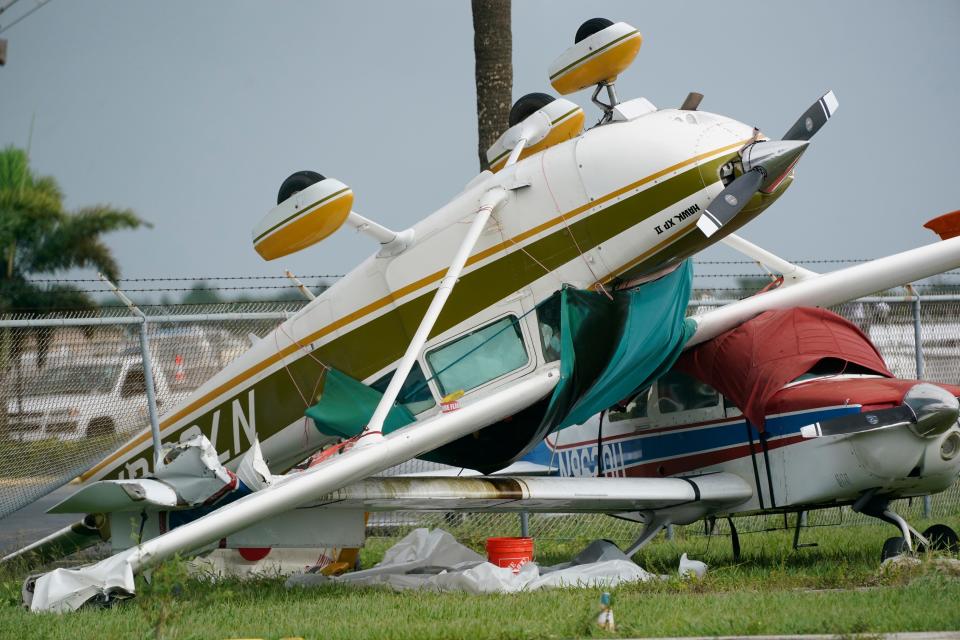Idalia may bring tornadoes: What to know about risk in Florida, Georgia and the Carolinas
Tornado warnings continued to pop up Wednesday in Florida and the Southeast as Hurricane Idalia roared through the area. Tornadoes are typically one of the dangers that develop both before and after hurricanes make landfall, and Idalia is no exception.
"A couple of tornadoes are possible today across central and northeast Florida into southeast Georgia," the National Hurricane Center said Wednesday morning. "The tornado threat will increase through this afternoon across coastal South Carolina and continue into tonight for coastal North Carolina."
The Storm Prediction Center has placed coastal portions of the Carolinas under an "enhanced risk" for severe storms, including tornadoes. This is Level 3 on the 5-level risk scale the SPC uses. A tornado watch was also in effect across the region, meaning conditions are ripe for tornadoes to form.
Overall, tornadoes aren't uncommon during tropical cyclones, (which is the umbrella term for all hurricanes, typhoons, and tropical storms): In fact, almost all hurricanes and tropical storms that make landfall in the United States spawn at least one tornado, provided enough of the storm's circulation moves over land, according to the National Oceanic and Atmospheric Administration (NOAA).
"These tornadoes most often occur in thunderstorms embedded in rain bands well away from the center of the hurricane," NOAA said. "However, they can also occur near the eyewall. Usually, tornadoes produced by tropical cyclones are relatively weak and short-lived, but they still pose a significant threat."
Idalia text message updates: Sign up to receive updates on Hurricane Idalia and its aftermath from journalists across the USA TODAY network

Why do hurricanes spawn tornadoes?
Hurricanes and tropical storms offer all the necessary weather elements to spawn tornadoes: They carry small, spinning supercells inside their outer bands, which are thunderstorms that can form twisters, Live Science reported.
Fueled by warm, moist ocean air, hurricanes – with their strong wind shear near the ground – can create an unstable atmosphere when they make landfall, and their swirling vortices can flip vertically into funnels.
Tornadoes spawned by tropical cyclones are also known to develop very quickly and be very transient in nature, the Capital Weather Gang said. They’re also usually tough to see because of low cloud bases in hurricanes.
Indeed, tornadoes produced in tropical systems can be especially dangerous as they are quick to spin up and can be obscured by darkness and rainfall, said AccuWeather.
More: 'Don't mess around with this': Historic Hurricane Idalia barrels toward Florida. Live updates
Gulf Coast states have the most tornadoes from hurricanes
Gulf Coast states tend to have the most frequent and significant hurricane tornado events, NOAA said, partly because of their tendency to have at least one state fully exposed to the right-front quadrant of the hurricane when landfall occurs there. The right-front quadrant of hurricanes contain the ingredients for tornadoes to form.
On Wednesday, however, the main threat area is along the Atlantic coast of the Carolinas, in the northeast quadrant of weakening Hurricane Idalia, the Storm Prediction Center said.
Most tornadoes occur on the day of landfall, or the next day
Although hurricanes can spawn tornadoes up to about three days after landfall, statistics show that most of the tornadoes occur on the day of landfall or the next day, NOAA said.
The worst tornado outbreak occurred during 2004’s Hurricane Ivan, which caused a multiday outbreak of 127 tornadoes. The deadliest hurricane-spawned tornado was in October 1964, when 22 people died in Larose, Louisiana, during a twister from Hurricane Hilda.
How do you stay safe in a tornado?
The National Weather Service provides a good list of tips to keep in mind to stay safe in a tornado.
Move to an interior room on the lowest floor of a sturdy building, a basement or safe room.
Avoid windows, skylights and glass doors.
If in a mobile home or outdoors, move to the closest substantial shelter and protect yourself from flying debris. Sheds and storage facilities do not make safe shelter.
If you’re at work or school, follow your tornado drill and proceed to your tornado shelter location quickly and calmly. Do not go to large open rooms such as cafeterias, gymnasiums or auditoriums.
If you’re in a vehicle, drive to the nearest shelter. If you don’t think you can make it, get down in your car and cover your head, or abandon your car and seek shelter in a low-lying area such as a ditch or ravine.
Contributing: Brandon Girod, Pensacola News Journal
This article originally appeared on USA TODAY: Hurricane Idalia tornado risk: Where and when is the danger?

